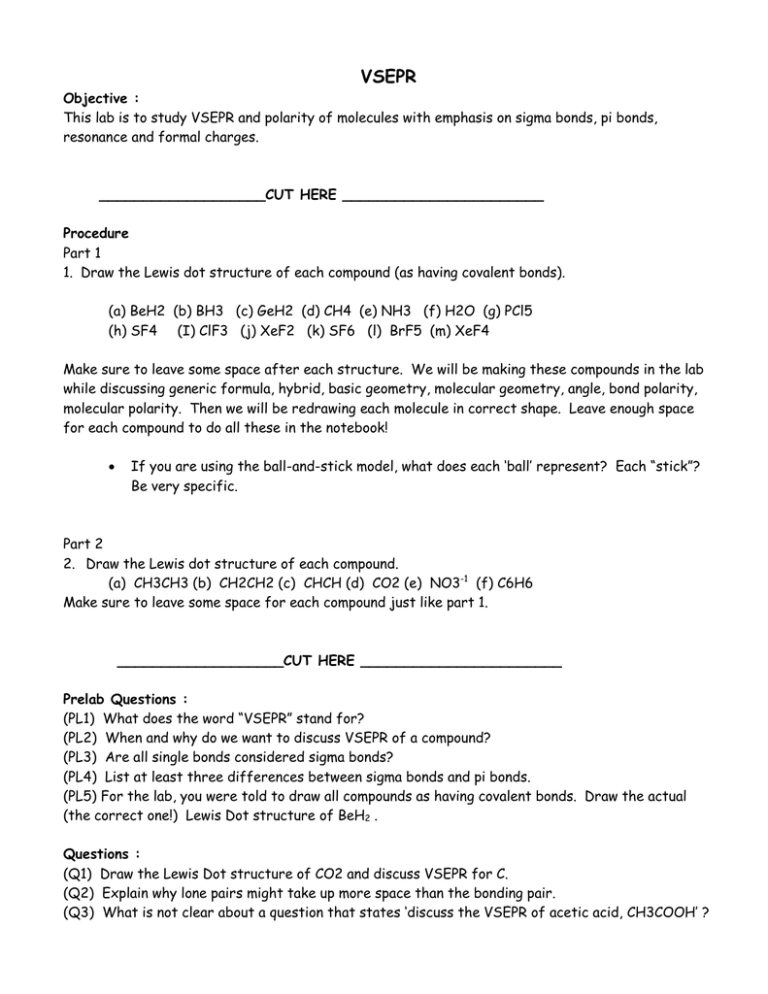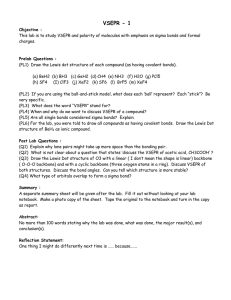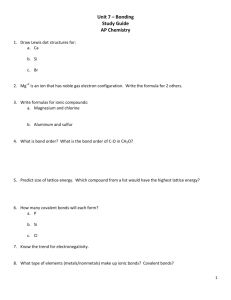VSEPR
advertisement

VSEPR Objective : This lab is to study VSEPR and polarity of molecules with emphasis on sigma bonds, pi bonds, resonance and formal charges. ___________________CUT HERE _______________________ Procedure Part 1 1. Draw the Lewis dot structure of each compound (as having covalent bonds). (a) BeH2 (b) BH3 (c) GeH2 (d) CH4 (e) NH3 (f) H2O (g) PCl5 (h) SF4 (I) ClF3 (j) XeF2 (k) SF6 (l) BrF5 (m) XeF4 Make sure to leave some space after each structure. We will be making these compounds in the lab while discussing generic formula, hybrid, basic geometry, molecular geometry, angle, bond polarity, molecular polarity. Then we will be redrawing each molecule in correct shape. Leave enough space for each compound to do all these in the notebook! If you are using the ball-and-stick model, what does each ‘ball’ represent? Each “stick”? Be very specific. Part 2 2. Draw the Lewis dot structure of each compound. (a) CH3CH3 (b) CH2CH2 (c) CHCH (d) CO2 (e) NO3-1 (f) C6H6 Make sure to leave some space for each compound just like part 1. ___________________CUT HERE _______________________ Prelab Questions : (PL1) What does the word “VSEPR” stand for? (PL2) When and why do we want to discuss VSEPR of a compound? (PL3) Are all single bonds considered sigma bonds? (PL4) List at least three differences between sigma bonds and pi bonds. (PL5) For the lab, you were told to draw all compounds as having covalent bonds. Draw the actual (the correct one!) Lewis Dot structure of BeH2 . Questions : (Q1) Draw the Lewis Dot structure of CO2 and discuss VSEPR for C. (Q2) Explain why lone pairs might take up more space than the bonding pair. (Q3) What is not clear about a question that states ‘discuss the VSEPR of acetic acid, CH3COOH’ ? (Q4) Draw the Lewis Dot structure of O3 with a linear ( I don’t mean the shape is linear) backbone ( O-O-O backbone) and with a cyclic backbone (three oxygen atoms in a ring). Discuss VSEPR of both structures. Explain why linear structure is more stable than the cyclic structure. (Q5) Draw energy diagram (before and after) for C in each compound in CH3CH3, Ch2CH2, and CHCH. Examples of energy diagram is found in Chapter 9 lecture notes slide 10 and 28…. (Q6) Draw energy diagram (before and after) for N in NO3-1. Count the electrons carefully. (Q7) What type of orbitals overlap to form a sigma bond? (Q8) What type of orbitals overlap to form a pi bond? (Q9) Which is stronger, sigma or pi? Explain. Summary : Part 1. A separate summary sheet will be given after the lab. Fill it out without looking at your lab notebook. Make a photo copy of the sheet. Tape the original to the notebook and turn in the copy as report. Part 2 Sketch each of 6 compounds and ions given in part 2 of procedure showing all sigma bonds (as a line) and pi bonds (as rubber bands). Shape matters! If the compound has resonance, draw ONE sketch of what it looks like at all times.




